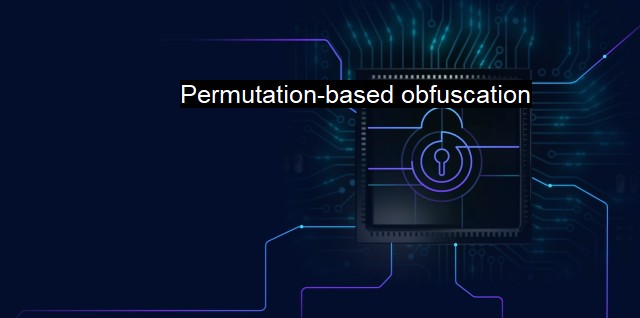What is Permutation-based obfuscation?
Outsmarting Antivirus: The Power of Permutation-Based Obfuscation in Cybersecurity
Permutation-based obfuscation is a high-level cybersecurity method, specifically in protecting software codes from unauthorized manipulation and reading by malicious hackers. In the realm of digital security, it tends to be highly effective in keeping software codes safe from efforts of reverse-engineering, where hackers attempt to understand the coding system and manipulate it to their advantage. Through the application of varying permutations, or arrangements of information in a designated sequence, the logic and structure of the code is systematically rearranged and disguised, making it difficult for hackers to interpret or steal valuable data.One of the alluring charms of permutation-based obfuscation for developers is its simplicity and ease of application. It typically involves various transformations, including loop transformations, code commercialization, and adding false code paths, to alter the original design of software and application codes. This approach drastically reduces the chances of critical data being captured by threat actors, by making the logic ambiguous and hard to decipher.
In this strategy, permutations are applied in a specific sequence such as data variables are rearranged in a manner that makes sense to the legitimate user or developer, yet appears totally jumbled and randomly arranged to anyone without reference to the original data order. This concealment significantly hinders the likelihood of the code's underlying algorithm been known and also protects its confidentiality from exploits. Simultaneously, it ensures the software functionality remains intact from the perspective of legitimate users, thereby maintaining productivity and utility.
Permutation-based obfuscation also plays a major role in protecting against antivirus evasion. Like with software codes, malicious actors often seek to trick antiviruses by creating polymorphic viruses and malware that alter each time they are copied or downloaded, to stealthily bypass initial scans. with sophisticated permutation-based obfuscation methods, antivirus programs are innately equipped to recognize patterns and decode the seemingly complex and altering nature of these malicious entities. They ensure antivirus solutions stay one step ahead of hackers by having the capacity to identify and neutralize harmful digital components regardless of how much they scramble to appear different.
In modern cyber warfare, permutation-based obfuscation has proven to be an effective security protocol in the war against cyber threats. It's a highly adaptive and fitting response that corresponds well to evolving threats like advanced persistent threats (APT) and zero-day exploits. With remarkable potential to add extra layers of impermeable security, it has fast become integral to modern cybersecurity tactics for many organizations, particularly those that provide services in cloud-based programming where data is stored remotely on the internet.
Undoubtedly, the ongoing cat and mouse game between cyber defenders and cyber threat actors has necessitated the utilisation of potent tools like permutation-based obfuscation. Whilst hackers continue to craft innovative ways to infiltrate systems and steal valuable data, skilled cybersecurity personnel should embrace combinations of strategies like permutation-based obfuscation to increase system resilience and bolster defenses.
It's important to not regard permutation-based obfuscation as a standalone protection measure, but rather a part of a wider, multifaceted security mechanism that includes intrusion detection systems, encryption, authentication, and antivirus software. As with any cybersecurity technique, consistently updating and adapting the obfuscation tactics in response to changing hacking strategies can substantially enhance an organization’s digital security. in an era of rapidly evolving threats, no singular approach is foolproof, but a combination of multiple dynamic defenses, including the use of permutation-based obfuscation can offer formidable resistance against potential cyber threats.

Permutation-based obfuscation FAQs
What is permutation-based obfuscation?
Permutation-based obfuscation is a cybersecurity technique that involves reshuffling the order of instructions in a software program in order to make it harder for antivirus programs to detect and analyze. This makes it difficult for hackers to reverse engineer or analyze the program, adding an extra layer of security to protect against cyberattacks.How does permutation-based obfuscation work?
Permutation-based obfuscation works by randomly rearranging the order of software instructions without changing the overall functionality of the program. This makes it difficult for antivirus programs to detect patterns or signatures that might indicate malicious code. By scrambling the code, hackers are less likely to be able to identify vulnerabilities that can be exploited.What are the benefits of permutation-based obfuscation?
Permutation-based obfuscation is a powerful cybersecurity tool because it can significantly reduce the risk of cyberattacks. By making it more difficult for hackers to analyze and exploit software programs, it can help improve the overall security of digital systems. This can be particularly useful in industries that rely heavily on secure digital systems, such as finance or healthcare.Are there any limitations to permutation-based obfuscation?
While permutation-based obfuscation can be effective in certain situations, it is not a foolproof solution. Hackers may still be able to find vulnerabilities in obfuscated code, and some antivirus programs are specifically designed to detect and analyze obfuscated software. In addition, obfuscation techniques such as permutation can sometimes cause performance issues or compatibility problems with other software. As with any cybersecurity technique, it is important to carefully evaluate the pros and cons of using permutation-based obfuscation in a given context.| | A | | | B | | | C | | | D | | | E | | | F | | | G | | | H | | | I | | | J | | | K | | | L | | | M | |
| | N | | | O | | | P | | | Q | | | R | | | S | | | T | | | U | | | V | | | W | | | X | | | Y | | | Z | |
| | 1 | | | 2 | | | 3 | | | 4 | | | 7 | | | 8 | | |||||||